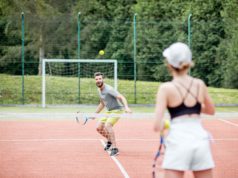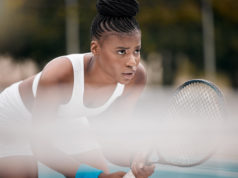By Luke Jensen, French Open Doubles Champion
Tennis is on! Seven million new tennis players picked up a racquet in 2020 in the United States. That is great news for the tennis industry coming out of a pandemic. Now, the question is how does the tennis industry keep those new players engaged in our sport? I recently finished a tour of clubs, public facilities, and high school tennis programs in the Midwest and West. During my trip, I traveled to Illinois, Nebraska, Iowa, South Dakota, Wyoming, Colorado, and Montana! It was so much fun, and I took in some great tennis country. What I found was that local tennis leaders spend time ensuring that their new players align with existing players to find matches and social tennis experiences. As the leagues come back into play, these tennis opportunities really fuel the tennis participation at all levels.
High school tennis is way up in participation numbers across the country. I couldn’t believe the number of players on the teams that I worked with. I’ve found that conducting live ball drills right away was beneficial because most of those players are seasonal and need real-world situations to be successful. Live ball is when you are rallying with someone and a dead ball is when someone feeds a ball to you. I start out every live ball session with reflex volleys with both players at the net working on a cooperative and consistent rally. Then both players back up and do the same thing from the ground strokes. I do various situations with moon balls back and forth, combined with slice shots. Any situation a player will see on the court is what I want them to prepare for on the practice court. I’ve had a great deal of success teaching the live ball method. The next time you jump on the court to work on your game, run drills and games based around the live ball; it will serve you well!
Mental Toughness
On the pro tour, the big news in June was Naomi Osaka refusing to do press conferences and ultimately leaving the French Open. Naomi is a smart person and player. She is always on the cutting edge of dynamic situations and seems to play even better with noise surrounding her. However, this time she felt that the press can be harsh and extremely critical. Naomi has spoken recently about her own mental health issues, raising awareness to the situation in general. Players with the money to absorb the fine have skipped press conferences in years past, but Naomi raises an issue that we should all take time and look into. I have worked with many young people whose number-one challenge is a lack of mental toughness. That also can be categorized as a mental health situation. The competition is so tough and harsh in pressure tennis. I’ve worked with players who felt their self-esteem was tied to the result of a match. If they won a match, they felt they were a good person, and just the opposite when they lost. As a player, I loved the game, but never felt a loss defined me as a person.
To be clear, I don’t question Naomi’s toughness on or off the court. She is shining a light on an important issue. In my years coaching, I have learned to listen first and take detailed notes on players to give important feedback. So many emotions are tied into their results, and it is crucial to be ultra-positive with the feedback to build a greater person who will play better tennis the next time they walk on the court.




